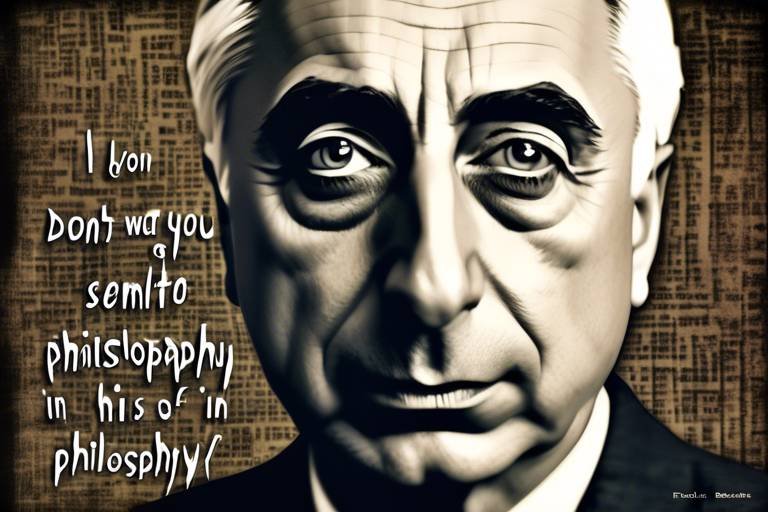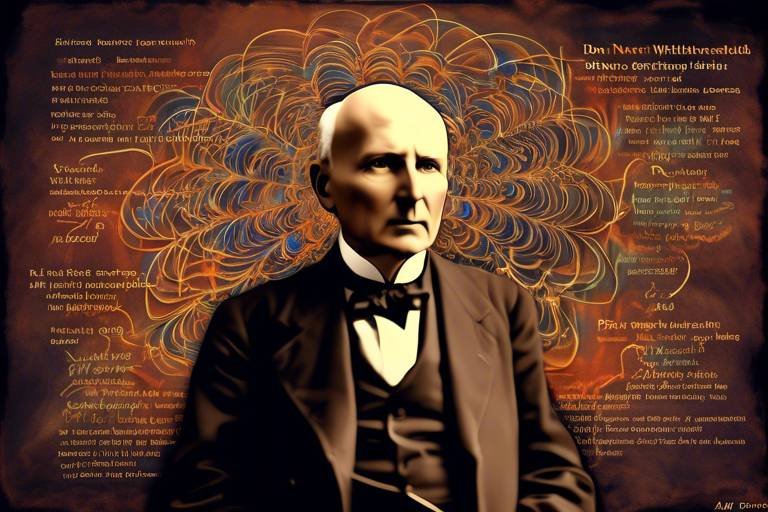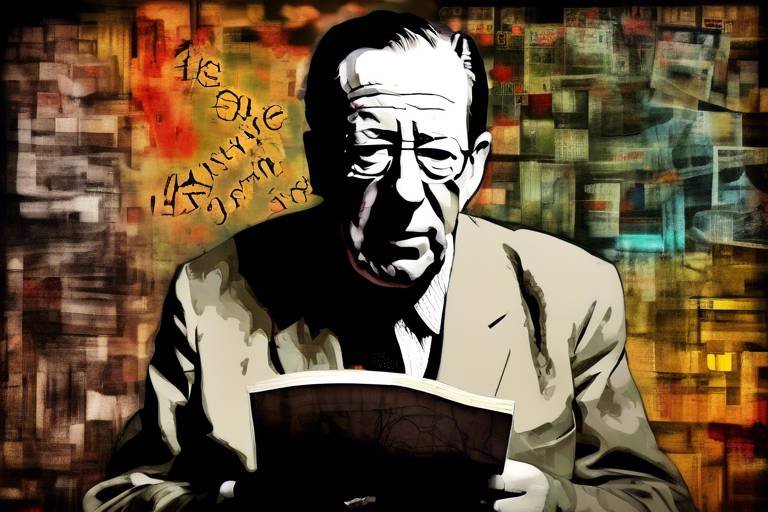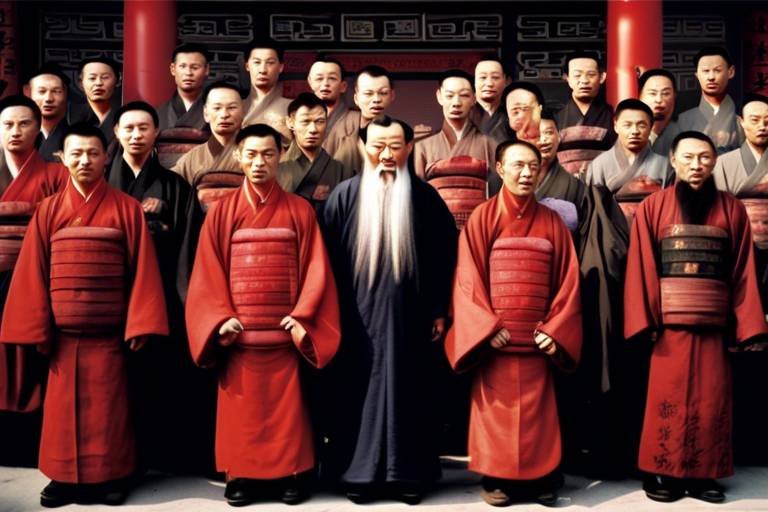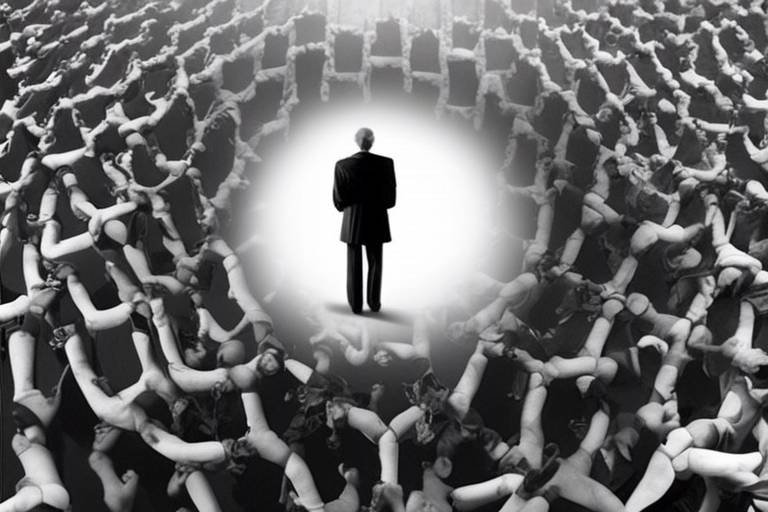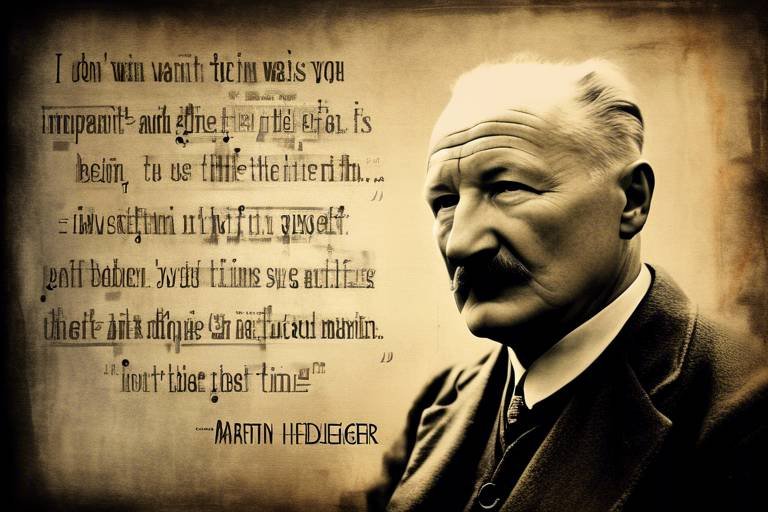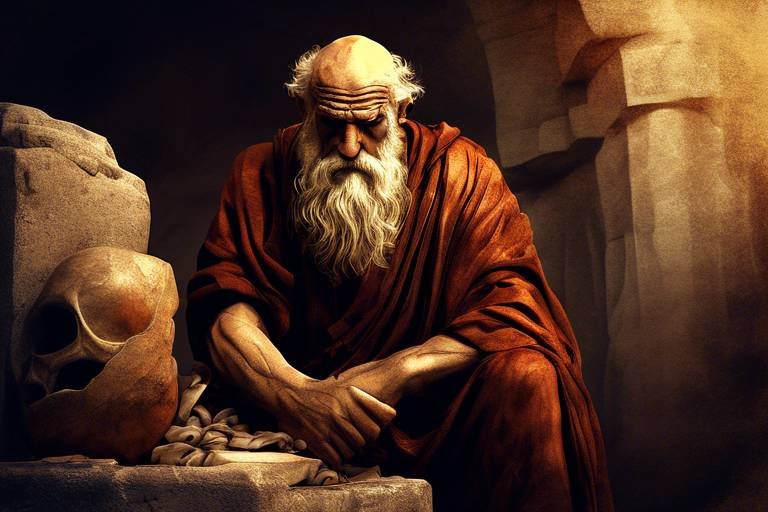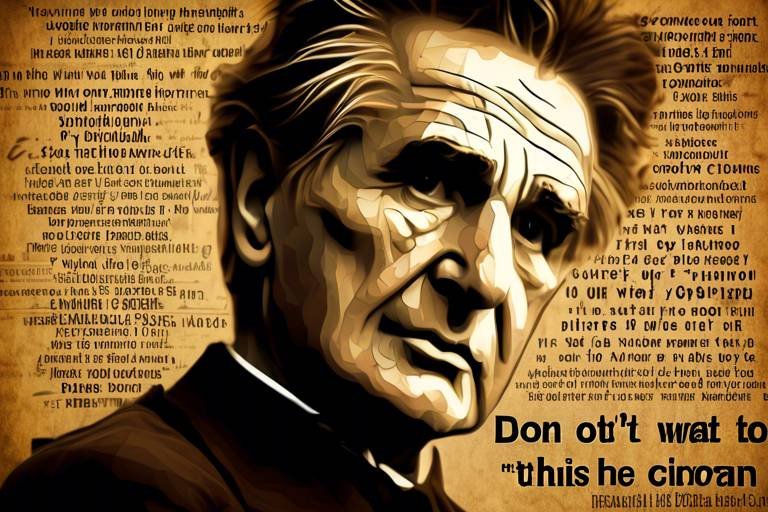Breaking Down Hegel’s Master-Slave Dialectic
When we think about power dynamics in relationships, it’s hard not to stumble upon the profound insights of Georg Wilhelm Friedrich Hegel. His concept of the Master-Slave Dialectic is not just a philosophical idea; it's a mirror reflecting the complexities of human interaction and the quest for recognition. Imagine a scenario where two individuals are vying for dominance, not just in terms of control but in their very identities. This dialectic explores how one person's self-consciousness is intertwined with another's, creating a fascinating yet tumultuous relationship.
At its core, the Master-Slave Dialectic illustrates a struggle for recognition, where the Master seeks validation through the Slave, while the Slave, through labor and experience, gains a deeper understanding of self. This dynamic is not merely about oppression; it’s about the evolution of consciousness and the realization of one's own identity through the lens of another. It’s like a dance where each partner influences the other's movements, sometimes leading, sometimes following, but always in a state of flux.
Hegel’s dialectic is significant because it lays the groundwork for understanding not only personal relationships but also broader social structures. It challenges us to consider how power operates in various contexts, whether in personal relationships, societal hierarchies, or even global politics. This exploration is crucial, especially in today’s world, where issues of identity, recognition, and power dynamics are more relevant than ever. So, why does this matter? Because recognizing the interplay of power can lead to a more profound understanding of ourselves and our relationships with others.
In the following sections, we will delve deeper into the nuances of Hegel’s Master-Slave Dialectic, examining its historical context, key themes, and implications for contemporary social theory. We will also explore critiques and interpretations that have emerged over time, enriching our understanding of this complex philosophical framework. So buckle up, as we embark on this intellectual journey through the intricate world of Hegel’s thought!
The Master-Slave Dialectic is a pivotal concept in Hegel's philosophy, encapsulating the intricate relationship between two consciousnesses. It serves as a lens through which we can analyze the dynamics of power and recognition. The dialectic begins with two individuals, each striving for self-consciousness. The Master, through domination, seeks to assert their identity, while the Slave, through servitude, embarks on a journey of self-discovery. This paradox of dependence and independence is what makes the dialectic so compelling.
What’s fascinating is that the Master, while appearing to hold power, is ultimately reliant on the Slave for their identity. Without the Slave's recognition, the Master’s self-conception crumbles. Conversely, the Slave, through their labor and experiences, begins to realize their own self-worth and becomes aware of their own consciousness. This twist is akin to a plot twist in a gripping novel, where the expected roles of power and submission are turned on their head.
In essence, Hegel’s Master-Slave Dialectic is not just about domination; it’s about the journey toward mutual recognition and the development of self-consciousness. It challenges us to rethink our assumptions about power, identity, and the nature of human relationships. As we navigate through this dialectic, we uncover layers of meaning that resonate with our everyday experiences and societal structures.
- What is the Master-Slave Dialectic?
It is a philosophical concept by Hegel that explores the dynamics of power and recognition between two individuals, illustrating how their identities are intertwined.
- How does the Master-Slave Dialectic apply to modern society?
This dialectic helps us understand contemporary issues of identity, power dynamics, and social relationships, revealing how these themes manifest in various contexts.
- What are the implications of Hegel's ideas on recognition?
Recognition is crucial for identity formation; understanding this can illuminate discussions about self and other in social theory.

Understanding the Master-Slave Dialectic
The Master-Slave Dialectic is one of the most profound and intricate concepts in Hegelian philosophy, encapsulating the dynamics of power, recognition, and consciousness between individuals. At its core, this dialectic illustrates the struggle for recognition, where two consciousnesses engage in a contest to establish their self-identity and autonomy. But what does this really mean? Imagine two people standing face to face, each vying for the other's acknowledgment. This isn't just a social interaction; it's a fundamental aspect of human existence that drives relationships, societies, and even history itself.
Hegel posits that this struggle leads to a division of roles: one becomes the Master, who asserts dominance, while the other becomes the Slave, who, despite being subjugated, ultimately gains self-awareness through labor and recognition. The Master enjoys immediate gratification and power, yet this power is precarious because it hinges on the Slave's recognition of the Master. Conversely, the Slave, while initially in a position of inferiority, develops a deeper understanding of their own identity through the act of working and creating. This paradox illustrates how dependence can lead to a form of freedom.
To break it down further, let's consider the implications of this dialectic in everyday life. The Master may appear to hold all the cards, basking in the glory of their perceived superiority. However, without the Slave's acknowledgment, the Master’s status is ultimately hollow. On the flip side, the Slave, through their labor, not only shapes the world around them but also cultivates their own self-consciousness. In this way, the Master-Slave relationship is not merely about domination; it is a complex interplay that highlights the necessity of mutual recognition for true identity formation.
In essence, the Master-Slave Dialectic serves as a microcosm for larger societal structures. It invites us to reflect on our own lives: Who are the Masters and Slaves in our relationships? How do we assert our identities? More importantly, how do we recognize others? These questions resonate deeply in contemporary discussions about power dynamics, identity, and social relationships, making Hegel's work not just a historical artifact but a living, breathing framework for understanding human interaction.

The Historical Context
To truly grasp Hegel’s Master-Slave Dialectic, one must first immerse themselves in the rich historical and philosophical backdrop of the early 19th century. This period was marked by significant upheaval and transformation, influenced by the Enlightenment, the rise of German Idealism, and the socio-political changes sweeping across Europe. Hegel's work did not emerge in a vacuum; rather, it was a response to the currents of thought and the realities of his time. As we explore this context, we can better appreciate how Hegel's ideas on power dynamics and recognition were not only revolutionary but also deeply rooted in the struggles of his era.
The Enlightenment, with its emphasis on reason, individualism, and the questioning of traditional authority, laid the groundwork for Hegel's dialectical method. Thinkers like Kant challenged the status quo, positing that knowledge and morality could be derived from human reason rather than divine revelation. This shift in perspective encouraged individuals to seek recognition and validation from their peers rather than relying on hierarchical structures. Hegel took these ideas further, suggesting that the quest for recognition is fundamental to self-consciousness and identity.
Furthermore, the impact of the French Revolution cannot be understated. The revolution symbolized a radical break from feudalism and a demand for equality and self-determination. Hegel observed the tumultuous events of this period and recognized that the struggle for recognition and self-identity was at the heart of human relationships. The Master-Slave Dialectic can be seen as a philosophical reflection on the power struggles that arise when individuals seek acknowledgment from one another in a society that is constantly in flux.
In addition to these broader movements, Hegel was influenced by his contemporaries, particularly German Idealists like Fichte and Schelling. Their explorations of self-consciousness and the nature of reality provided a fertile ground for Hegel’s thoughts. Fichte, for instance, emphasized the role of the self in shaping reality, while Schelling introduced the idea of the Absolute, which Hegel would later integrate into his dialectical framework. This interplay of ideas highlights how Hegel’s dialectic was not merely a product of his imagination but a culmination of existing philosophical discourse.
To summarize, the historical context surrounding Hegel's Master-Slave Dialectic is essential for understanding its significance. The Enlightenment's emphasis on rationality, the revolutionary spirit of the age, and the contributions of German Idealism all converged to shape Hegel's thoughts. Recognizing these influences allows us to appreciate the depth of his ideas and their implications for social theory and human relationships.

Influence of German Idealism
The Master-Slave Dialectic is deeply rooted in the philosophical tradition of German Idealism, which emerged in the late 18th and early 19th centuries. This movement was characterized by a shift from empirical realism to a focus on the mind and its role in shaping reality. Hegel, as one of its most prominent figures, built upon the ideas of earlier German idealists, particularly Johann Gottlieb Fichte and Friedrich Wilhelm Joseph Schelling. Their contributions were pivotal in shaping Hegel’s understanding of self-consciousness and the development of the dialectical method.
Fichte's notion of the self as a dynamic entity that requires recognition from others laid the groundwork for Hegel's exploration of interpersonal relationships. He argued that the self cannot exist in isolation; it must engage with another self to fully realize its identity. This idea resonates profoundly in the Master-Slave Dialectic, where the struggle for recognition becomes a central theme. The tension between the master and the slave encapsulates this need for acknowledgment, as each party's identity is constructed through their relationship with the other.
Schelling, on the other hand, introduced the concept of absolute idealism, emphasizing the interconnectedness of all reality. His ideas about the nature of existence and the synthesis of opposites influenced Hegel's dialectical approach. Hegel took these notions further, arguing that history itself is a rational process where contradictions are resolved through a synthesis that leads to higher forms of consciousness. This process is evident in the Master-Slave Dialectic, where the conflict between the master and the slave ultimately leads to a greater understanding of freedom and self-awareness.
To illustrate the influence of these thinkers, consider the following table that summarizes their key contributions:
| Philosopher | Key Contribution |
|---|---|
| Johann Gottlieb Fichte | Emphasis on the self's need for recognition |
| Friedrich Wilhelm Joseph Schelling | Concept of absolute idealism and synthesis of opposites |
In summary, the influence of German Idealism on Hegel's Master-Slave Dialectic cannot be overstated. It provided a rich philosophical framework that allowed Hegel to delve into the complexities of recognition and self-consciousness. By synthesizing the ideas of Fichte and Schelling, Hegel crafted a dialectic that not only examines the dynamics of power but also highlights the essential human need for acknowledgment and identity formation. This intricate web of thought continues to resonate in contemporary discussions about identity and social relationships.
- What is the Master-Slave Dialectic? It is a philosophical concept by Hegel that explores the dynamics of power and recognition between individuals.
- How did German Idealism influence Hegel? German Idealism shaped Hegel's ideas about self-consciousness and the dialectical method, particularly through the works of Fichte and Schelling.
- What are the key themes of the Master-Slave Dialectic? Key themes include recognition, dependence, and the development of self-consciousness.

Fichte and Schelling’s Contributions
When we dive into the philosophical waters of Hegel's Master-Slave Dialectic, we can't overlook the ripples created by two towering figures: Johann Gottlieb Fichte and Friedrich Wilhelm Joseph Schelling. These philosophers not only shaped Hegel's thoughts but also laid the groundwork for the intricate dance of self-consciousness and the nature of reality that Hegel would later expand upon. Their ideas are like the roots of a tree, providing nourishment and support to Hegel’s philosophical branches.
Fichte's concept of the self was revolutionary. He proposed that the self is defined through its opposition to the non-self. In other words, we come to understand who we are by recognizing what we are not. This notion of duality is crucial to Hegel's dialectic, where the struggle for recognition between the master and the slave unfolds. Fichte argued that this recognition is essential for the development of self-consciousness, which is a key theme in Hegel's work. Without the acknowledgment from another, the self remains isolated, a mere shadow of its potential.
On the other hand, Schelling introduced the idea of absolute freedom, which plays a significant role in understanding the dynamics of the master-slave relationship. He posited that true freedom is not merely the absence of constraints but is found in the recognition of one’s place in a larger context. This perspective aligns with Hegel's assertion that the master-slave dialectic is not just about domination, but rather a complex interdependence where both parties are shaped by their interactions. In this way, Schelling's thoughts contribute to the understanding of how freedom and recognition are intertwined in the development of consciousness.
To illustrate their contributions further, let’s break down some of the key ideas from Fichte and Schelling that influenced Hegel:
| Philosopher | Key Contribution | Impact on Hegel |
|---|---|---|
| Fichte | Self defined through opposition | Foundation for self-consciousness in dialectic |
| Schelling | Absolute freedom and recognition | Complexity of interdependence in master-slave dynamic |
In essence, Fichte and Schelling acted as the philosophical bridge that Hegel crossed to arrive at his own theories. Their emphasis on recognition, self-consciousness, and the interplay of freedom and dependence set the stage for Hegel's exploration of how individuals relate to one another in a social context. Just as a sculptor chisels away at a block of stone to reveal the form within, Hegel sculpted his ideas using the foundational concepts laid down by Fichte and Schelling. This interplay of ideas not only enriches our understanding of Hegel’s dialectic but also invites us to reflect on our own relationships and the dynamics of recognition that shape our identities.

The Role of Enlightenment Thought
The Enlightenment was a pivotal moment in history, a time when reason and individualism began to take center stage, reshaping the way people viewed themselves and their relationships with others. This intellectual movement laid the groundwork for Hegel’s Master-Slave Dialectic, as it emphasized the importance of personal autonomy and the quest for recognition. Enlightenment thinkers like Kant, Rousseau, and Locke argued that individuals possess inherent rights and should be treated as ends in themselves, rather than means to an end. This philosophical shift was crucial for Hegel, as it provided a backdrop against which he could explore the dynamics of power and recognition.
At the heart of Enlightenment thought was the idea that human beings are rational agents capable of shaping their own destinies. This belief in rationality and self-determination directly influenced Hegel's conception of self-consciousness. For Hegel, the struggle for recognition between the master and the slave is not merely a fight for dominance; it is a profound existential quest where both parties seek to affirm their identities through the acknowledgment of the other. This relationship illustrates how deeply intertwined power dynamics are with the desire for self-affirmation, a theme that resonates strongly with Enlightenment ideals.
Moreover, the Enlightenment's emphasis on individual rights and freedoms can be seen as a double-edged sword in the context of the Master-Slave Dialectic. While these ideas promote the notion of equality and mutual recognition, they also expose the inherent tensions in social hierarchies. The master, who enjoys the privileges of recognition, often does so at the expense of the slave, who is relegated to a position of subservience. This paradox raises critical questions about the nature of freedom and the conditions under which true recognition can occur. In this light, Hegel’s dialectic becomes a lens through which we can examine the complexities of societal structures and the ongoing struggle for identity and autonomy.
In summary, the Enlightenment laid the philosophical groundwork for Hegel’s exploration of the Master-Slave Dialectic. By advocating for reason, individual rights, and the pursuit of recognition, Enlightenment thinkers influenced Hegel’s understanding of self-consciousness and the intricate dance of power between individuals. As we continue to grapple with these themes in contemporary society, it becomes increasingly clear that the legacy of Enlightenment thought remains relevant in discussions about identity, autonomy, and the quest for mutual recognition.
- What is the Master-Slave Dialectic?
The Master-Slave Dialectic is a philosophical concept developed by Hegel that explores the dynamics of power, recognition, and consciousness between individuals. - How does Enlightenment thought relate to Hegel's philosophy?
Enlightenment thought emphasizes reason and individual rights, which influenced Hegel's ideas about self-consciousness and the struggle for recognition in the Master-Slave Dialectic. - Why is recognition important in Hegel's dialectic?
Recognition is crucial as it forms the basis of identity and self-consciousness, highlighting the interdependent relationship between individuals in the struggle for acknowledgment. - What are the implications of the Master-Slave Dialectic for modern social theory?
The dialectic has significant implications for understanding power dynamics, identity formation, and social relationships in contemporary contexts.

Key Themes in the Dialectic
The Master-Slave Dialectic is a profound exploration of the complexities of human relationships and the intricate dynamics of power and recognition. At its core, the dialectic reveals several key themes that are essential for understanding not only Hegel's philosophy but also the broader implications for social interactions. One of the most significant themes is the notion of recognition. In this framework, recognition is not merely a passive acknowledgment; it is an active engagement that shapes identity and consciousness. The struggle for recognition between the master and the slave highlights how individuals are defined through their relationships with others. This is akin to a dance where each partner influences the other's movements, creating a complex choreography of identity.
Another crucial theme is dependence. The master-slave relationship is marked by a paradoxical interdependence where the master relies on the slave for their own sense of power and identity, while the slave, through their labor and submission, contributes to the master’s status. This dynamic can be likened to a two-sided coin; while one side may appear dominant, the other is equally essential for the whole to exist. This interdependence raises questions about autonomy and freedom, challenging the notion that power is a straightforward hierarchy. Instead, it suggests that power is a fluid and relational construct.
Furthermore, the development of self-consciousness is a pivotal theme within the dialectic. Hegel posits that self-consciousness arises from the recognition of oneself in the other. This relationship is not only about dominance but also about the struggles and sacrifices made in the pursuit of self-identity. The slave, through their labor and the experience of subjugation, begins to develop a deeper understanding of their own consciousness, ultimately leading to a transformation that challenges the initial power dynamics. This evolution can be seen as a metaphor for personal growth; sometimes, it takes hardship and struggle to truly understand oneself and one's place in the world.
In summary, the key themes of recognition, dependence, and self-consciousness are interwoven within the Master-Slave Dialectic, each contributing to a richer understanding of human relationships and societal structures. These themes invite us to reflect on our own interactions and the ways in which power and identity are constructed in our lives.
- What is the Master-Slave Dialectic? - It is a philosophical concept by Hegel that explores the dynamics of power and recognition between individuals.
- How does recognition play a role in the dialectic? - Recognition is essential for identity formation and is an active process through which individuals define themselves in relation to others.
- What are the implications of the Master-Slave Dialectic in modern society? - The dialectic influences contemporary discussions on power dynamics, identity, and social relationships, shedding light on how these elements interact in various contexts.

Implications for Social Theory
The implications of Hegel’s Master-Slave Dialectic stretch far beyond the confines of philosophy and seep into the very fabric of social theory. At its core, this dialectic illustrates the intricate dance of power dynamics and identity formation that shapes human relationships. When we consider the interactions between individuals, it becomes clear that the quest for recognition is not merely a philosophical abstraction but a fundamental aspect of social existence. This struggle for recognition is akin to a game of tug-of-war where both parties are vying for validation and respect, yet it is this very conflict that ultimately leads to growth and self-awareness.
In contemporary discussions, the Master-Slave Dialectic serves as a lens through which we can examine various social structures and relationships. For instance, think about how this dialectic plays out in different contexts, such as workplaces, communities, and even in online interactions. The dynamics of dominance and submission, while often viewed through a negative lens, can also foster a deeper understanding of how identities are formed and transformed. When one individual recognizes another's existence and worth, it not only validates that person but also reinforces the recognizer's own identity. This reciprocity is crucial for the development of self-consciousness and social cohesion.
Moreover, the implications of Hegel’s ideas can be observed in modern social movements. The fight for civil rights, gender equality, and social justice can all be framed within the context of the Master-Slave Dialectic. Activists often seek recognition not just for themselves but for entire communities that have been marginalized or oppressed. This quest for acknowledgment drives social change and highlights the interconnectedness of individual and collective identities. In this sense, the dialectic is not just a theoretical construct but a practical tool for understanding and navigating the complexities of social relations.
To illustrate these points further, consider the following table that outlines some key implications of the Master-Slave Dialectic in social theory:
| Aspect | Implication |
|---|---|
| Power Dynamics | Understanding how power is negotiated and contested in relationships. |
| Identity Formation | Recognizing the role of recognition in shaping self-identity. |
| Social Movements | Framing struggles for rights and recognition as dialectical processes. |
| Interpersonal Relationships | Exploring how recognition and dependence influence personal dynamics. |
In conclusion, Hegel’s Master-Slave Dialectic provides profound insights into the nature of social theory. It compels us to consider how recognition, power, and identity are interwoven in the tapestry of human interaction. By understanding these dynamics, we can better navigate the complexities of our social world and foster more meaningful connections with others.
- What is the Master-Slave Dialectic? It is a philosophical concept by Hegel that explores the dynamics of recognition and power between individuals.
- How does this dialectic relate to social theory? It helps to explain how identities are formed through recognition and how power dynamics influence social relationships.
- Can the Master-Slave Dialectic be applied to modern social movements? Yes, it can frame the struggles for civil rights and recognition as dialectical processes that reveal the complexities of power and identity.

Recognition and Identity Formation
The concept of recognition in Hegel's Master-Slave Dialectic serves as a crucial cornerstone for understanding identity formation. Recognition is not just a simple acknowledgment of existence; it is a profound interaction that shapes how individuals perceive themselves and others. In a world where we often seek validation from those around us, Hegel's ideas resonate deeply, illustrating that our identities are inherently linked to the recognition we receive from others. This interplay creates a complex web where self-consciousness is not merely an internal affair but a relational dynamic that unfolds in social contexts.
When we think about identity, it’s essential to recognize that it is not static. Instead, it is a fluid construct shaped by our interactions and the recognition we garner from others. This is where the Master-Slave Dialectic becomes particularly illuminating. The master and the slave exist in a relationship that is both dependent and transformative. The master gains a sense of superiority and self-definition through the recognition of the slave, while the slave, in turn, develops self-consciousness through the labor and struggle for recognition. It’s a fascinating dance of power and dependence that highlights the **interconnectedness** of identity.
To break it down further, we can consider some key aspects of how recognition influences identity formation:
- Mutual Recognition: For identity to flourish, it requires a reciprocal acknowledgment. Without this mutual recognition, individuals may struggle to form a coherent sense of self.
- Social Context: Identity is heavily influenced by the social environment. The dynamics of recognition can shift based on cultural, political, and historical contexts.
- Conflict and Growth: Struggles for recognition can lead to conflict, but they also provide opportunities for personal and collective growth. The tension between the master and the slave ultimately fosters self-awareness and evolution.
In essence, recognition is not just about being seen; it’s about being understood and validated in one’s existence. This is particularly relevant in contemporary discussions about identity politics, where marginalized groups seek recognition as a means of asserting their identity and rights. Hegel’s dialectic serves as a powerful lens through which we can examine these dynamics, emphasizing that our identities are always in flux, shaped by the relationships we forge and the recognition we seek.
Q: How does Hegel's concept of recognition differ from modern interpretations?
A: Hegel's notion of recognition emphasizes the relational aspect of identity, suggesting that self-consciousness emerges through interactions with others. Modern interpretations often focus on individualistic notions of identity, sometimes overlooking the importance of social relationships.
Q: Can recognition lead to conflict?
A: Yes, the struggle for recognition can lead to conflict, as individuals or groups may feel denied acknowledgment. However, such conflicts can also be catalysts for change and growth, prompting deeper understanding and new forms of recognition.
Q: How does this concept apply to contemporary social issues?
A: The dynamics of recognition are highly relevant in discussions about race, gender, and class. Movements advocating for social justice often center around the need for acknowledgment and validation of identities that have historically been marginalized.

Power Dynamics in Society
The Master-Slave Dialectic proposed by Hegel is not just an abstract philosophical concept; it has profound implications for understanding power dynamics within society. At its core, the dialectic illustrates how relationships of domination and submission shape human interactions, influencing everything from personal relationships to institutional structures. Imagine a dance where one partner leads and the other follows; this dynamic can be seen in various contexts, revealing the intricate balance of power that defines social relations.
In today’s society, the interplay of power often manifests in several ways, including economic inequality, political authority, and social hierarchies. The Master-Slave Dialectic helps us understand that these relationships are not static but are continuously evolving. For instance, consider how the relationship between employers and employees can mirror the master-slave dynamic. Employers wield power through control over resources and decision-making, while employees may find themselves in a position of dependency, striving for recognition and fair treatment.
Moreover, the dialectic can be applied to various social contexts, such as:
- Racial Dynamics: The historical context of slavery and colonialism illustrates how power is exercised and resisted, leading to ongoing struggles for equality and recognition.
- Gender Relations: The patriarchal structures in society often place men in dominant positions, while women and marginalized genders navigate a landscape shaped by these power imbalances.
- Political Structures: The relationship between the state and its citizens can reflect master-slave dynamics, where authority figures exert control over the populace, leading to resistance and demands for recognition.
Understanding these dynamics can lead to greater awareness of how power operates in our lives. It opens up discussions about agency and resistance, emphasizing that the 'slave' or subordinate position is not merely passive. Instead, it can be a site of struggle and transformation, where individuals seek to assert their identity and demand recognition from those in power. This struggle is crucial for social change, as it challenges existing hierarchies and promotes a more equitable society.
In essence, Hegel's Master-Slave Dialectic provides a lens through which we can examine the complexities of power in contemporary society. By recognizing the fluidity of these relationships, we can better understand the mechanisms of oppression and the potential for liberation. As we navigate our social landscape, the questions of who holds power and how it is challenged remain ever-relevant, urging us to reflect on our roles within these dynamics.
- What is the Master-Slave Dialectic? It is a philosophical concept by Hegel that explores the dynamics of power and recognition between individuals.
- How does the Master-Slave Dialectic apply to modern society? It reflects the ongoing struggles for power and recognition in various social contexts, including race, gender, and economic relations.
- Can the dialectic be seen in everyday relationships? Yes, the dynamics of domination and submission can be observed in personal and professional relationships, influencing how individuals interact with one another.

Critiques and Interpretations
The Master-Slave Dialectic has not only been a cornerstone of Hegelian philosophy but has also sparked a myriad of critiques and interpretations over the years. Various philosophers and theorists have engaged with Hegel’s ideas, each bringing their own perspectives and critiques to the table. This ongoing dialogue is crucial for understanding the broader implications of Hegel’s work and how it resonates in contemporary discussions. One of the most significant critiques comes from the Marxist perspective, which interprets Hegel's dialectic through the lens of class struggle and economic relations.
Marxists argue that Hegel’s dialectic, while profound, is fundamentally idealistic and overlooks the material conditions that shape human existence. In Marx’s view, the Master-Slave relationship can be seen as a metaphor for class struggle, where the ruling class (the Master) maintains power over the working class (the Slave). This interpretation emphasizes the economic dimensions of power dynamics and suggests that true emancipation comes not from recognition but from the overthrow of oppressive structures. The dialectic, therefore, becomes a tool to analyze social relations in terms of material conditions rather than mere consciousness.
On the other hand, feminist theorists have also engaged critically with the Master-Slave Dialectic, arguing that Hegel’s framework can be applied to understand gender dynamics. Feminist critiques highlight how the dialectic illustrates the power imbalances inherent in patriarchal societies. The struggle for recognition, as posited by Hegel, can be reinterpreted to reflect the experiences of women and marginalized genders seeking acknowledgment and agency in a male-dominated world. This perspective raises questions about how identity is constructed not just through recognition but also through the systemic inequalities that shape social interactions.
To further illustrate the various critiques and interpretations of Hegel's Master-Slave Dialectic, we can summarize some key perspectives in the following table:
| Perspective | Key Insights |
|---|---|
| Marxist Critique | Focuses on class struggle and economic relations, viewing the dialectic as a metaphor for oppression and liberation. |
| Feminist Perspectives | Examines gender dynamics through the dialectic, emphasizing the struggle for recognition and agency in patriarchal structures. |
| Postcolonial Critique | Analyzes the implications of the dialectic in colonial and postcolonial contexts, questioning how power dynamics play out across cultures. |
These critiques not only enrich our understanding of Hegel’s work but also highlight the ongoing relevance of the Master-Slave Dialectic in contemporary philosophical discourse. Each interpretation offers a unique lens through which to examine the complexities of power, recognition, and identity, making it a dynamic area of study that continues to evolve.
- What is the Master-Slave Dialectic? The Master-Slave Dialectic is a philosophical concept developed by Hegel that explores the dynamics of recognition and power between individuals.
- How does the Marxist critique interpret Hegel's dialectic? The Marxist critique emphasizes class struggle, viewing the Master-Slave relationship as a metaphor for the oppression of the working class by the ruling class.
- What do feminist theorists argue about the Master-Slave Dialectic? Feminist theorists argue that the dialectic can be applied to understand gender dynamics and the struggle for recognition and agency in a patriarchal society.
- Why is the Master-Slave Dialectic relevant today? The Master-Slave Dialectic remains relevant as it provides insight into contemporary discussions about power dynamics, identity formation, and social relationships.

Marxist Critique
The of Hegel's Master-Slave Dialectic offers an intriguing lens through which to understand not just the philosophical underpinnings of power dynamics, but also the economic implications that arise from them. Karl Marx, while deeply influenced by Hegel's ideas, sought to reinterpret the dialectic in a way that highlighted the material conditions of existence rather than the abstract notions of consciousness and recognition. For Marx, the struggle between the master and the slave is not merely a philosophical exercise; it is emblematic of the broader class struggles inherent in capitalist society.
One of the central tenets of Marx's critique is the idea that the master-slave relationship can be seen as a metaphor for the class struggle between the bourgeoisie (the masters) and the proletariat (the slaves). In this framework, the master represents the capitalist who exploits labor for profit, while the slave symbolizes the working class that is subjugated and alienated from the fruits of their labor. This interpretation shifts the focus from individual recognition to collective economic struggle, emphasizing how social relations are fundamentally shaped by material conditions.
Marx argued that the master’s power is contingent upon the slave’s labor. Without the labor of the slave, the master’s status and wealth would be unsustainable. This dependency creates a dynamic where the master is not truly free, as their freedom is dependent on the oppression of the slave. In this sense, the dialectic illustrates a paradox: the more the master seeks to assert their dominance, the more they reveal their own dependence on the very entity they seek to control. This relationship can be further understood through the following points:
- Alienation of Labor: The worker becomes alienated from their own labor, which is commodified and exploited, leading to a loss of self and identity.
- Class Consciousness: The oppressed class must develop a collective awareness of their exploitation in order to challenge the status quo.
- Revolutionary Potential: Marx believed that the contradictions inherent in capitalism would ultimately lead to its downfall and the rise of a classless society.
This critique highlights the limitations of Hegel’s dialectic when applied to social structures. While Hegel emphasizes the role of recognition and consciousness in the development of self, Marx redirects attention to the material and economic relations that underpin these identities. In doing so, he provides a more pragmatic approach to understanding power dynamics, emphasizing that true freedom can only be achieved through the abolition of class distinctions and the establishment of a society where the means of production are collectively owned.
In summary, the Marxist critique of Hegel’s Master-Slave Dialectic serves as a powerful reminder that philosophical ideas are often deeply intertwined with economic realities. By reframing the dialectic in terms of class struggle, Marx not only critiques Hegel’s idealism but also lays the groundwork for a revolutionary theory that seeks to address the inequities of capitalist society. This perspective continues to resonate today, as discussions around power, identity, and economic disparity remain ever relevant.
- What is the Master-Slave Dialectic? The Master-Slave Dialectic is a concept from Hegel's philosophy that explores the dynamics of power and recognition between individuals, representing a struggle for self-consciousness.
- How does Marx interpret the Master-Slave Dialectic? Marx interprets the dialectic as a metaphor for class struggle, emphasizing the economic relationships and material conditions that shape societal dynamics.
- What are the implications of the Marxist critique? The Marxist critique challenges the idealistic framework of Hegel by focusing on economic exploitation and the need for collective action to achieve true freedom.

Feminist Perspectives
The Master-Slave Dialectic offers a compelling framework for understanding the dynamics of power, but it has also drawn significant critique from feminist scholars. These thinkers argue that Hegel's original formulation, while groundbreaking, largely reflects a male-centric view of relationships and power structures. Feminists assert that the dialectic can be reinterpreted to better encompass the complexities of gender dynamics. For instance, the struggle for recognition is not just a battle between two individuals but can also be seen through the lens of societal expectations and the roles imposed on different genders.
One of the key contributions of feminist theory to the Master-Slave Dialectic is the emphasis on how gendered power dynamics shape identity and relationships. Feminist scholars argue that the dialectic can be expanded to include the ways in which women have historically been positioned as 'the Other' in relation to men. This positioning creates a different kind of dependency and recognition struggle, where women seek acknowledgment not only as individuals but also as integral participants in the social fabric. This perspective highlights how the quest for recognition can manifest in various forms, including the fight for rights, representation, and respect in both public and private spheres.
Furthermore, feminist interpretations of the Master-Slave Dialectic often focus on the implications of patriarchy and how it influences the consciousness of both men and women. For instance, the idea that one must dominate in order to achieve self-consciousness may perpetuate harmful stereotypes and reinforce oppressive structures. Feminists argue that true recognition can only be achieved through mutual acknowledgment and respect, rather than through domination and subjugation. This rethinking opens up a dialogue about how power can be shared and how relationships can evolve to be more equitable.
In addition to these theoretical contributions, feminist perspectives also bring attention to the lived experiences of women and how these experiences reflect the dynamics of the Master-Slave relationship. Women often navigate complex social landscapes where they must assert their identity while simultaneously contending with societal norms that seek to diminish their agency. By examining these experiences through the dialectic lens, feminists can illuminate the subtle ways in which power operates in everyday life.
Overall, integrating feminist perspectives into the Master-Slave Dialectic enriches our understanding of power, recognition, and identity. It challenges us to reconsider who is recognized, how recognition is achieved, and what it means to exist in a world where power dynamics are constantly shifting. This ongoing conversation not only deepens our grasp of Hegel's ideas but also pushes us toward a more inclusive and equitable interpretation of human relationships.
- What is the Master-Slave Dialectic?
The Master-Slave Dialectic is a philosophical concept introduced by Georg Wilhelm Friedrich Hegel that explores the dynamics of recognition and power between individuals.
- How do feminist perspectives reinterpret the Master-Slave Dialectic?
Feminist scholars argue that the dialectic reflects a male-centric view and advocate for a broader understanding that incorporates gender dynamics and the experiences of women.
- Why is recognition important in the context of the Master-Slave Dialectic?
Recognition is crucial because it shapes identity and influences power dynamics in relationships, highlighting the struggle for acknowledgment in both personal and societal contexts.
- What are some implications of the Master-Slave Dialectic for modern society?
The dialectic informs discussions about power structures, identity formation, and the complexities of social relationships in contemporary contexts.
Frequently Asked Questions
- What is Hegel's Master-Slave Dialectic?
The Master-Slave Dialectic is a philosophical concept introduced by Georg Wilhelm Friedrich Hegel that explores the relationship between two self-consciousnesses. It highlights how one individual (the Master) gains recognition and power over another (the Slave) and how this dynamic shapes their identities and consciousness.
- Why is the Master-Slave Dialectic significant in philosophy?
This dialectic is significant because it illustrates the struggle for recognition that is central to human relationships. It reveals how power dynamics influence identity formation and consciousness, which are crucial themes in Hegel's broader philosophical framework.
- How does historical context influence Hegel's ideas?
Hegel's ideas were shaped by the philosophical currents of his time, particularly German Idealism and Enlightenment thought. These influences helped him develop concepts of self-consciousness, individualism, and rationality, which are essential to understanding the Master-Slave Dialectic.
- What role did Fichte and Schelling play in Hegel's dialectic?
Fichte and Schelling significantly influenced Hegel's thoughts on self-consciousness and reality. Their ideas laid the groundwork for Hegel's exploration of the relationships between individuals and the development of consciousness, which are pivotal in the Master-Slave Dialectic.
- How does the Master-Slave Dialectic relate to social theory?
Hegel's Master-Slave Dialectic has profound implications for contemporary social theory, particularly in discussions about power dynamics and identity. It helps us understand how recognition and social relationships shape individual identities and societal structures.
- What are the critiques of Hegel's Master-Slave Dialectic?
Various critiques exist, notably from Marxist and feminist perspectives. Marx critiques the economic implications of the dialectic, focusing on class struggle, while feminist theorists examine how gender dynamics can be interpreted through Hegel's framework, highlighting its relevance in contemporary feminist discourse.
- How does recognition play a role in identity formation?
In Hegel's framework, recognition is crucial for identity formation. It emphasizes that individuals develop their sense of self through interactions with others. This mutual recognition is fundamental to understanding how identities are constructed in social contexts.
- Can the Master-Slave Dialectic be applied to modern power dynamics?
Absolutely! The Master-Slave Dialectic continues to be relevant in analyzing modern power dynamics, as it offers insights into how relationships of domination and submission manifest in various social contexts, from personal relationships to broader societal structures.


